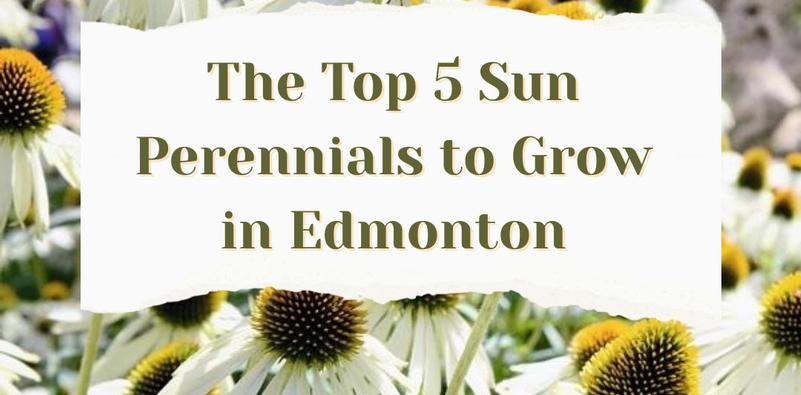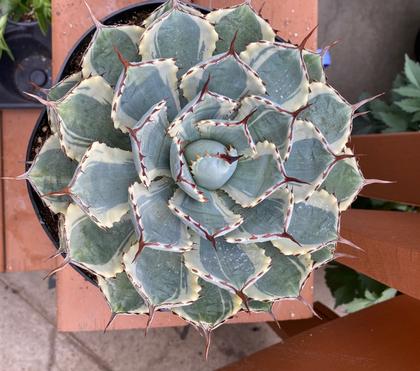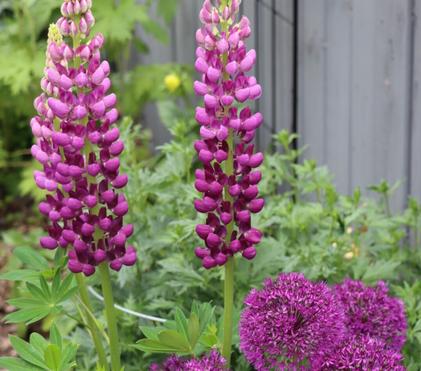Sun Lovin' Perennials
As a new gardener, it can be difficult to know where to start. In my first year, I was extremely ambitious, filling my cart with whatever plants caught my fancy. I didn’t consider the level of care each plant required, and before long, I was dealing with a garden full of pests and crispy plants. The next year, I found myself more tentative to begin. I didn’t want to repeat my previous mistakes, but I wasn’t quite sure which plants were best for my yard and how to properly care for them.
If you can relate, let me help you out with some practical tips: start small, and begin with what’s tried and true. Once you gain more knowledge and confidence in your gardening skills, you can gradually explore a wider variety of plants.
In the next few blogs, I’ll walk you through some tried-and-true plant options for the Edmonton area and the basics of caring for them. All the plants below are cold hardy and relatively low maintenance making them perfect for Edmonton and newer gardeners. Let’s start with sun-loving perennials that thrive in our region’s climate.

#1Hemerocallis
Commonly known as Daylilies, Hemerocallis has vibrant blooms in a wide range of colors. Daylilies have varying bloom times—some flower in late spring, while others bloom in mid-summer. By planting a mix of varieties with different bloom periods, you can enjoy pops of color throughout the spring and summer. For specific bloom times of each variety, be sure to check our website. Many of the daylilies we offer are also rebloomers, ensuring an extended period of vibrant flowers.
Care Instructions:
- Sun & Soil: Thrives in full sun but can tolerate part shade. Plant them after the last spring frost in moist, well-drained soil 18-24 inches apart.
- Watering: When first planted water 2-3 times a week. Water deeply during dry spells, especially when they are in bloom. Avoid over-watering, as daylilies don’t like soggy soil. Somewhat drought-tolerant once established (1 growing season).
- Deadheading: It's beneficial to deadhead spent blooms to maintain a tidy appearance and encourage new flowers.
- Winter Care: After foliage dies back, cut it down to about 2-3 inches above the ground. Leave mulch in place for added insulation.
- Dividing: Every 3-5 years, divide your daylilies to prevent overcrowding and keep them healthy.
- Pests: They may attract aphids or slugs. Regularly check for pests and use insecticidal soap or diatomaceous earth for organic control.
- Leaf Spot Disease: A fungal disease appearing as yellow or brown spots on leaves. Prevent it by avoiding overhead watering, removing infected foliage, and ensuring good air circulation.
- Overcrowding: If your daylilies are no longer blooming as profusely or look overcrowded, it’s time to divide them.
#2 Echinacea (Coneflower)
Echinacea is prized for its medicinal properties and ability to attract pollinators. With a variety of colors and heights, it blooms in mid-summer and produces long-lasting flowers.
Care Instructions:
- Sun & Soil: Echinacea thrives in full sun (at least 6 hours daily) and well-drained soil.
- Watering: Once established, it is drought-tolerant, but regular watering during the first growing season is essential. Water deeply, allowing the soil to dry between waterings.
- Deadheading: Regularly remove spent blooms to encourage more flowers, but leaving some to go to seed will attract birds.
- Winter Care: After blooming, cut back flower stems and foliage to 2-3 inches above the ground. Alternatively, leave the seed heads for winter texture in your garden.
- Dividing: Divide plants every 2-3 years in early spring or early fall to maintain health and vigor.
- Aphids: Remove with a stream of water or insecticidal soap.
- Cutworms: Protect young plants with diatomaceous earth or organic pest controls.
- Powdery Mildew: Prevent by spacing plants for good air circulation and watering at the base.
- Root Rot: Ensure well-drained soil and avoid overwatering to prevent root rot.
#3 Paeonia
These lightly scented, bushy perennials are perfect for cut flowers and attracting pollinators to your garden. They come in many varieties and colours and will return year after year. Some peonies can last for 50-100 years with the proper care!
Care Instructions:
- Sun & Soil: Peonies need full sun (at least 6 hours daily) and well-drained soil.
- Watering: Water deeply during dry spells, especially during their first year. Fairly drought tolerant but regular water helps produce and sustain big blooms.
- Support: Edmonton’s spring winds and rain can topple heavy blooms, so consider using plant supports or hoops just as new shoots emerge.
- Winter Care: Cut stems to the ground in the fall after the first frost. This helps prevent fungal diseases.
- Dividing: Dividing plants is generally not necessary. If you do, divide every 10-15 years in the fall.
- Botrytis Blight (Gray Mold): Remove and discard infected parts (don’t compost). Cut plants down in the fall, clean up debris, and space plants for good circulation. Avoid overhead watering.
- Powdery Mildew: Ensure good spacing and airflow. Fungicide optional but usually not needed
- Root Rot: Ensure well-drained soil and avoid overwatering to prevent root rot.
#4 Sedum
So low maintenance you can just about plant them and forget them! Sedums have unique foliage and clusters of small flowers. Not only are they trendy because of their cool foliage, but they are also tried and true for Edmonton gardening. Sedums come in a wide range of varieties, offering different shapes, sizes, and textures. Some form low, spreading ground cover, while others grow tall and produce beautiful blooms in the fall.
Care Instructions:
- Sun & Soil: sedums prefer full sun (at least 6 hours daily) and well-drained soil. Avoid wet or heavy clay soil.
- Watering: Water regularly when getting established. Once established water during prolonged dry spells only. Overwatering can cause rot.
- Aphid: occasional aphids may be seen. Remove with a stream of water or insecticidal soap if there is a large amount of them.
- Rot: soggy conditions will cause rot. Make sure they are in an area that has good drainage.
#5 Salvia
Salvia’s intense, blue-purple flower spikes add rich colour to a garden. They continuously bloom if deadheaded and attract hummingbirds. Frost and heat tolerance makes them a great option for the weather extremes in the Edmonton area.
Care Instructions:
- Sun & Soil: Salvia thrives in full sun (6plus hours). Plant them in the spring once the soil has warmed in a location with good drainage. Salvia does not like “wet feet.”
- Watering: Water regularly when getting established. Once established water during prolonged dry spells only.
- Deadheading: cut back spent flowers to encourage reblooming in late summer.
- Winter Care: leave standing for the winter. Cut back in early spring before new growth starts.
- Pests/Disease: Occasional aphids or powdery mildew in humid conditions—prune for airflow and avoid overhead watering if needed.

